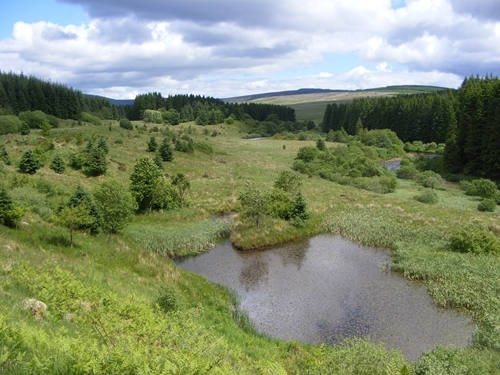Those watching BBC Breakfast News yesterday would have rightly been excited to see a report on the bog restoration project undertaken by Forestry England in Northumberland’s Border Mires. For many viewers, the segment’s provocative title - Why cutting down trees can be good for the climate – might be the first time they had given thought to the idea of alternative land uses.
The story is a captivating one. 87-year-old conservationist Angus Lunn has been interested in the ancient bogs since starting his PhD over 60 years ago, a time when public money was still fuelling the drainage of the area to create Europe’s largest manmade woodland, Kielder Forest.
Today Kielder is dominated by conifers, largely Sitka spruce, areas of which are being cleared in order to revitalise the bogs. As the BBC's Chief Environment Correspondent Justin Rowlatt reports, these bogs are an amazing store of carbon, sometimes as much as 15 metres deep.

Photo credit: Jo Jakeman
The Forestry Commission’s tree-planting drive, launched in the 1920s, was well-intentioned. At the time, the demand for a national reserve of timber was compelling. It does, however, prompt one to consider how there is no singularly correct land use, and that every decision offers some form of compromise.
Before the 1920s, Kielder was an open moorland much as you would find in other areas of the UK today. Pockets of woodland sat alongside moors managed for grouse shooting and used for sheep grazing. It isn’t alone. It is estimated that 20% of former moorland in the UK has been afforested with coniferous plantations and this has dramatically altered the habitat, with ground-nesting birds the main group to suffer. In south-west Scotland alone, it is believed that at least 5,000 breeding pairs of curlew have been lost, largely because of forestry. This is in addition to the impact of draining for forestry on the nation’s carbon storage. As the broadcast points out in simple terms, bogs are better for the environment than trees as they can store carbon for thousands of years.
Ironically, it is those moor owners who haven’t carpeted their land with trees who get the most blame for drainage. Journalists, the RSPB and politicians continue to lay the blame for drainage at the door of grouse moors, even though many upland landowners, including grouse moor owners, are actively blocking drains to restore moorland. The Moorland Association has reported an estimate by Natural England that around 18,000 hectares of moorland habitat on grouse moors have been restored in this way across northern England, supporting carbon-capturing plants such as Sphagnum moss.
Could history repeat itself?
One question that those calling for an end to driven grouse shooting struggle to answer is: what would go in its place? Whilst a state-funded acquisition of private moorland is almost inconceivable a century on from the creation of a body to ‘survey, purchase, lease and plant land’, commercial forestry is one possible alternative. This would, however, overlook just how fortunate we are to have heather moorland, a landscape recognised as being of global importance by the 1992 Rio Convention on Biodiversity.
In just three minutes, the BBC has shown just what is at stake if we ignore the lessons of the past and turn these internationally significant landscapes into vast blocks of forestry or pasture. Hopefully, those watching will have a fresh approach to the role our well-managed uplands have to play in the fight against climate change.